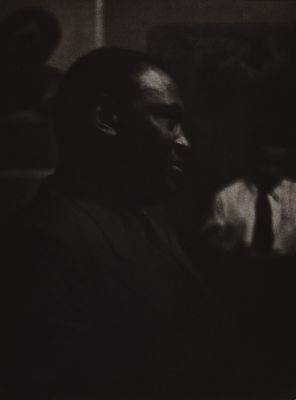
Title
5 MenArtist
DeCarava, Roy (American, 1919-2009)Publication
Twelve PhotographsDate
1990 plate (1964 negative)Process
PhotogravureAtelier
Renaissance Press, New HampshireImage Size
21 x 27 cm
This moment occurred during a memorial service for the children killed in a church in Birmingham Alabama in 1964. The photograph shows the men coming out of the service at a church in Harlem. The men were coming out of the church with faces so serious and so intense that I responded, and the image was made. DeCarava explained his feelings when taking the image: The motivation at that moment was my political understanding of the treatment of black people and their response to injustice… I wasn’t at the bombing, I wasn’t in the church, but I knew what it was and I wanted to make a picture that dealt with it. The men were coming out of the church with faces so serious and so intense, and the image was made.
For over fifty years Roy DeCarava has photographed people and places in his home of New York. His luxurious use of the dark tonal range is legendary, as is the compassion with which he captures his subjects. His photographs reflect issues that are as deeply personal as they are social. For the richness of experience his images suggest and the expressiveness of his printing style, one critic has justly described DeCarava as a "poet of light."
Following his training as a painter at The Cooper Union and the Harlem Arts Center, Roy DeCarava turned to the camera. It was the directness of the medium that attracted me, he later explained his switch from the paintbrush to the camera lens. Through the camera I was able to make contact with the world and express my feelings about it more directly. Employing his painterly eye and affinity for graphic design, DeCarava was not concerned with capturing the likeness of his subjects but their spirit and humane touch. His printing decisions, likewise, did not merely revolve around clarity but atmosphere. As such, DeCarava’s images are not meant to be interpreted as mere visual recorders of the African American demographic they capture so poetically but rather as emotionally charged and likewise evocative of the space and time in which they were first taken. As an oeuvre, DeCarava’s works provide a richly illuminating and expressive narrative of an era and time that may have otherwise gone amiss.
DeCarava’s career in photography enjoyed longevity and recognition from an early stage. In 1951, at the age of 32, he became the ninth photographer and the first African American to win a Guggenheim Fellowship. In 1955 his first book was published, one of 5 he would come to produce throughout his career. In 2001 DeCarava was the recipient of the Gold Medal in Photography from the National Arts Club and five years later he was awarded the National Medal of Arts from the National Endowment for the Arts. [1]
Reproduced / Exhibited
Exhibition catalog RISD Museum of Art – A Century of Black Photographers, 1983 (cover)
MOMA Roy DeCarava : a retrospective Peter Galassi, with an essay by Sherry Turner DeCarava 1996 p. 179
References
[1] Phillips https://www.phillips.com/detail/roy-decarava/NY040212/165 cited 2/14/23

